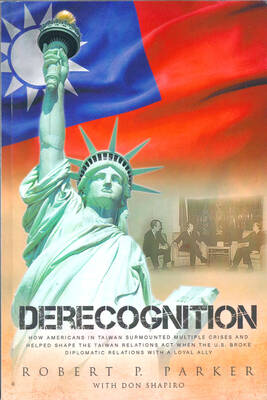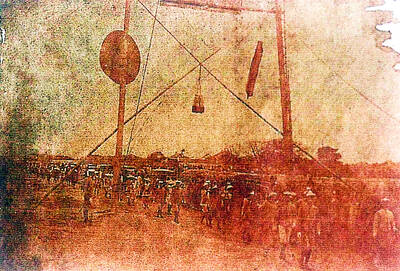Under a three-quarter moon Thursday, Aug. 7, in the sagebrush country of north central Washington state, 19 riders toed their horses up to the starting line atop Suicide Hill, overlooking the Okanogan River and whooping at the crowd across the valley.
At a starter's gun, the group charged toward the precipice, careering down 61m. Under the illumination of four dim floodlights, all that could be seen was a flurry of dust, hooves and flailing whips.

PHOTO: REUTERS
This is the Suicide Race, the most notorious and dangerous of the scores of so-called Indian horse races across the Northwest, and the biggest attraction at this town's annual rodeo, the Omak Stampede.
For four nights riders spur their horses down the hill and into the shallows of the Okanogan. A quick swim and sprint up the opposite bank finishes each race.
It is all over in less than a minute, but for young jockeys, particularly members of the nearby Confederated Tribes of the Colville Reservation, the Suicide Race is the surest route to stardom in the fast and loose world of Indian horse racing.
A race on Thursday night made the dangers clear. As the pack neared the bottom of the hill a horse faltered, setting off a tumbling of limbs, horse and human.
Seconds later 14 riders emerged, and one, 16-year-old Louis Zacherle, lay motionless on the bank. It was his first Suicide Race, and he completed the river crossing lying across the bow of a rescue boat instead of in the saddle. He was taken to a hospital, where he regained consciousness.
Among the more fortunate riders was Jonathan Abrahamson, known as Johnny Cakes.
On Thursday night, the first race, Abrahamson, 25, took second place. He went on to finish second Friday and Saturday nights, and on Sunday he claimed the overall title, which brings with it a new saddle and bragging rights until next year.
"We do racing stuff all year, but this is the only one I sweat for," Abrahamson said.
The race has drawn sharp criticism from animal welfare groups, who call it the cruelest in the world and say it has killed 15 horses since 1983. Another horse was put to death after breaking its shoulder in Friday night's race, Stampede officials said.
"It's one of those things that we're fundamentally opposed to," said Brian Sodergren, a spokesman for the Humane Society of the United States in Washington, DC.
Suicide Race horse owners and jockeys acknowledge the dangers the race poses for horses and riders, but deflect any criticism. Abrahamson said spirited horses loved to race as much as riders did. "You can tell they want it, those horses," he said.
On a recent afternoon, sitting in the shade of pine tree at the home of Kevin and Sylvia Carden, Abrahamson and his hosts discussed the race's significance to Native Americans. "To me, it's the Super Bowl of all of our horse racing we do around here," Abrahamson said.
Carden, president of the Suicide Race Owners and Jockeys Association, and her husband, a former racer, own horses in this year's race.
Carden, 40, said that some riders raced for money and others for fame, but that Suicide Hill was also a proving ground for young men of the Colville Reservation, which covers 566,560 hectares of north central Washington and is home to descendants of 12 tribes.
"It's a sign of maturity coming off that hill," Carden said.
The race has its roots in the Northwest's bygone days, when tribes would gather to collect roots or to fish for salmon, and young men would seek glory and diversion by racing wild horses across the coulee country east of the Cascade Mountains.
"Horse races have always been a part of Indian culture," Michael Marchand, vice chairman of the Colville Business Council, said in a telephone interview from an energy conference in New Mexico. "We used to have kind of a warrior society, and we can't go to war anymore, so this is a way for the young boys to kind of prove their bravery."

One of the biggest sore spots in Taiwan’s historical friendship with the US came in 1979 when US president Jimmy Carter broke off formal diplomatic relations with Taiwan’s Republic of China (ROC) government so that the US could establish relations with the People’s Republic of China (PRC). Taiwan’s derecognition came purely at China’s insistence, and the US took the deal. Retired American diplomat John Tkacik, who for almost decade surrounding that schism, from 1974 to 1982, worked in embassies in Taipei and Beijing and at the Taiwan Desk in Washington DC, recently argued in the Taipei Times that “President Carter’s derecognition

This year will go down in the history books. Taiwan faces enormous turmoil and uncertainty in the coming months. Which political parties are in a good position to handle big changes? All of the main parties are beset with challenges. Taking stock, this column examined the Taiwan People’s Party (TPP) (“Huang Kuo-chang’s choking the life out of the TPP,” May 28, page 12), the Democratic Progressive Party (DPP) (“Challenges amid choppy waters for the DPP,” June 14, page 12) and the Chinese Nationalist Party (KMT) (“KMT struggles to seize opportunities as ‘interesting times’ loom,” June 20, page 11). Times like these can

June 23 to June 29 After capturing the walled city of Hsinchu on June 22, 1895, the Japanese hoped to quickly push south and seize control of Taiwan’s entire west coast — but their advance was stalled for more than a month. Not only did local Hakka fighters continue to cause them headaches, resistance forces even attempted to retake the city three times. “We had planned to occupy Anping (Tainan) and Takao (Kaohsiung) as soon as possible, but ever since we took Hsinchu, nearby bandits proclaiming to be ‘righteous people’ (義民) have been destroying train tracks and electrical cables, and gathering in villages

Dr. Y. Tony Yang, Associate Dean of Health Policy and Population Science at George Washington University, argued last week in a piece for the Taipei Times about former president Ma Ying-jeou (馬英九) leading a student delegation to the People’s Republic of China (PRC) that, “The real question is not whether Ma’s visit helps or hurts Taiwan — it is why Taiwan lacks a sophisticated, multi-track approach to one of the most complex geopolitical relationships in the world” (“Ma’s Visit, DPP’s Blind Spot,” June 18, page 8). Yang contends that the Democratic Progressive Party (DPP) has a blind spot: “By treating any